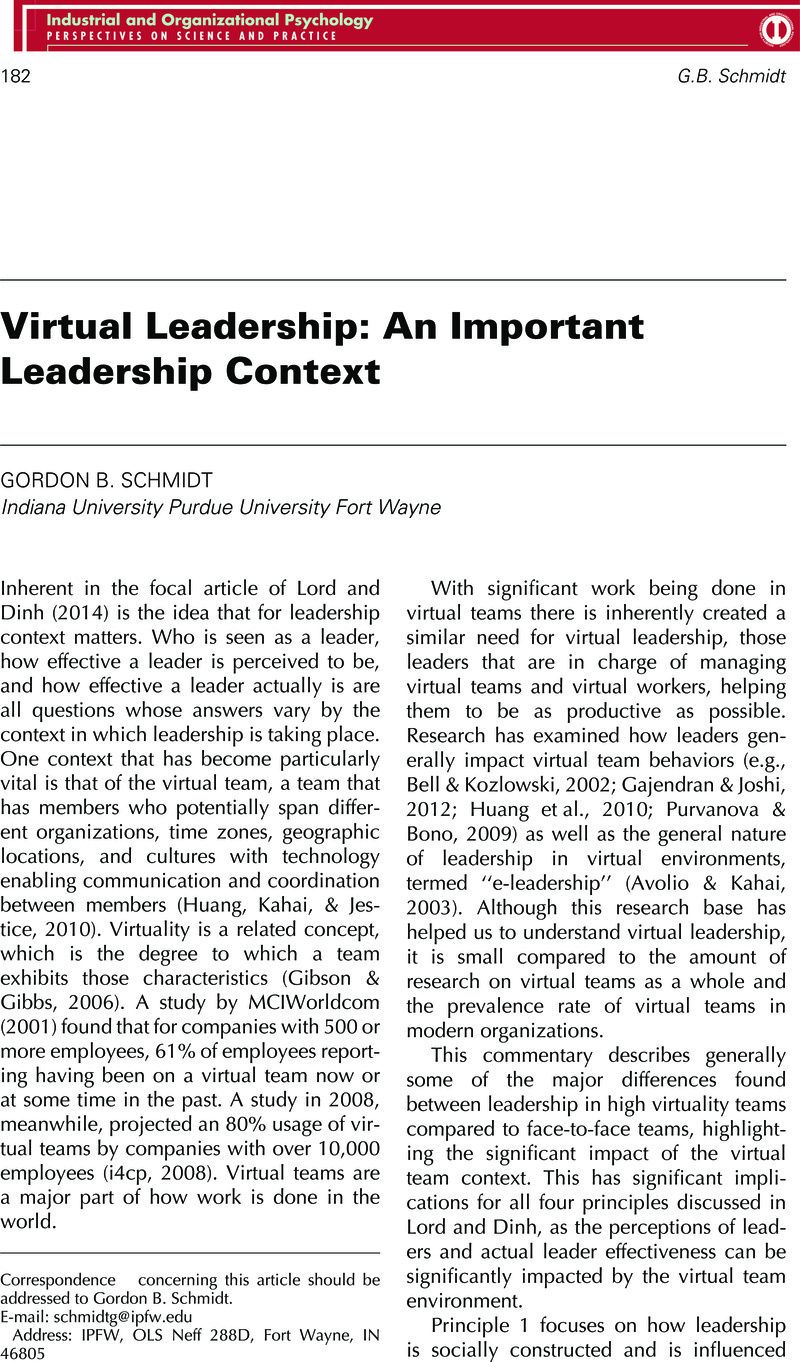Crossref Citations
This article has been cited by the following publications. This list is generated based on data provided by Crossref.
Lord, Robert G.
Dinh, Jessica E.
and
Hoffman, Ernest L.
2015.
A Quantum Approach to Time and Organizational Change.
Academy of Management Review,
Vol. 40,
Issue. 2,
p.
263.
Ardichvili, Alexandre
Natt och Dag, Kristina
and
Manderscheid, Steven
2016.
Leadership Development.
Advances in Developing Human Resources,
Vol. 18,
Issue. 3,
p.
275.
Hanges, Paul J
Aiken, Juliet R
Park, Joo
and
Su, Junjie
2016.
Cross-cultural leadership: leading around the world.
Current Opinion in Psychology,
Vol. 8,
Issue. ,
p.
64.
Márquez-Ramos, Laura
and
Mourelle, Estefanía
2016.
Selecting a Suitable Approach to Analyze the Future of Higher Education.
Procedia - Social and Behavioral Sciences,
Vol. 228,
Issue. ,
p.
86.
Black, Stephanie L.
Washington, Montressa L.
and
Schmidt, Gordon B.
2016.
Social Media in Employee Selection and Recruitment.
p.
197.
Morris, Lonnie R.
Morse, Christine
and
Jones, Ta Karra
2017.
Handbook of Research on Instructional Systems and Educational Technology.
p.
216.
Blau, Gary
Drennan, Rob B.
Karnik, Satyajit
and
Kapanjie, Darin
2017.
Do Technological and Course‐Related Variables Impact Undergraduates’ Perceived Favorability and Willingness to Recommend Online/Hybrid Business Courses?.
Decision Sciences Journal of Innovative Education,
Vol. 15,
Issue. 4,
p.
349.
Handke, Lisa
Schulte, Eva-Maria
Schneider, Kurt
Kauffeld, Simone
and
Ribeiro, Nelson
2018.
The medium isn’t the message: Introducing a measure of adaptive virtual communication.
Cogent Arts & Humanities,
Vol. 5,
Issue. 1,
Jeske, Debora
and
Axtell, Carolyn M.
2018.
The Nature of Relationships in e-Internships: A Matter of the Psychological Contract, Communication and Relational Investment.
Revista de Psicología del Trabajo y de las Organizaciones,
Vol. 34,
Issue. 2,
p.
113.
Shaw-VanBuskirk, Leslie
Lim, Doo Hun
and
Jeong, Shin-Hee
2019.
Liminal leadership: leading betwixt and between.
European Journal of Training and Development,
Vol. 43,
Issue. 7/8,
p.
643.
Wesche, Jenny S.
and
Sonderegger, Andreas
2019.
When computers take the lead: The automation of leadership.
Computers in Human Behavior,
Vol. 101,
Issue. ,
p.
197.
Morris, Lonnie R.
Morse, Christine
and
Jones, Ta Karra
2019.
Computer-Assisted Language Learning.
p.
1624.
Handke, Lisa
Schulte, Eva-Maria
Schneider, Kurt
and
Kauffeld, Simone
2019.
Teams, Time, and Technology: Variations of Media Use Over Project Phases.
Small Group Research,
Vol. 50,
Issue. 2,
p.
266.
Schmidt, Gordon B.
2019.
The Future of Leadership is Virtual.
Journal of Leadership Studies,
Vol. 12,
Issue. 4,
p.
63.
Loucks, Susan
and
Ozogul, Gamze
2020.
Preparing Business Students for a Distributed Workforce and Global Business Environment: Gaining Virtual Leadership Skills in an Authentic Context.
TechTrends,
Vol. 64,
Issue. 4,
p.
655.
McCarron, Graziella P.
Jackson, Grant R.
McNaughtan, Jon L.
Olesova, Larisa
Schmidt, Gordon B.
and
Adams, Tarra Taylor
2020.
Centering Dialogic and Digital Approaches in Leadership Education Pedagogy: Priority 6 of the National Leadership Education Research Agenda 2020–2025.
Journal of Leadership Studies,
Vol. 14,
Issue. 3,
p.
72.
Thambusamy, Roslind X.
and
Bekirogullari, Zafer
2020.
Virtual Leadership in Small Businesses during the COVID-19 Pandemic: Challenges and Possibilities.
The European Journal of Social & Behavioural Sciences,
Vol. 29,
Issue. 3,
p.
179.
Landers, Richard N.
and
Marin, Sebastian
2021.
Theory and Technology in Organizational Psychology: A Review of Technology Integration Paradigms and Their Effects on the Validity of Theory.
Annual Review of Organizational Psychology and Organizational Behavior,
Vol. 8,
Issue. 1,
p.
235.
Imam, Tasadduq
2021.
Good practices of delivery and teaching leadership for online educators in technical disciplines: A perspective.
STEM Education,
Vol. 1,
Issue. 2,
p.
92.
Wald, Peter M.
2021.
Aktuelle Führungstheorien und -konzepte.
p.
385.



